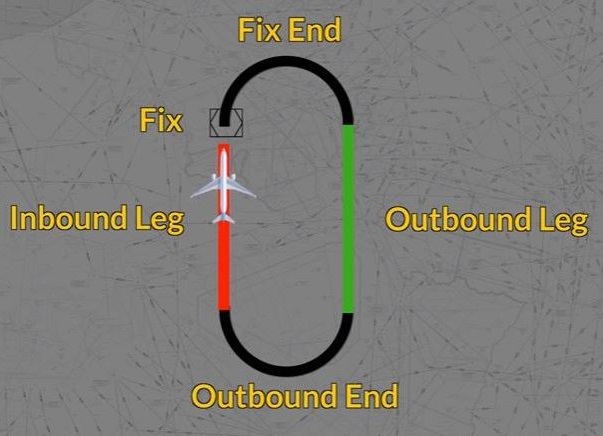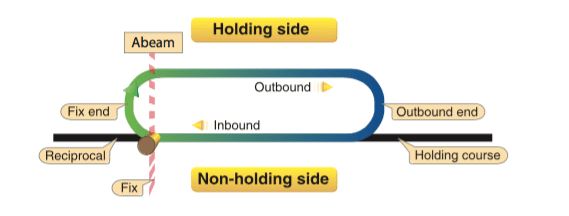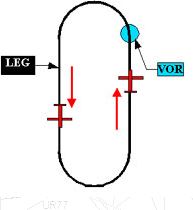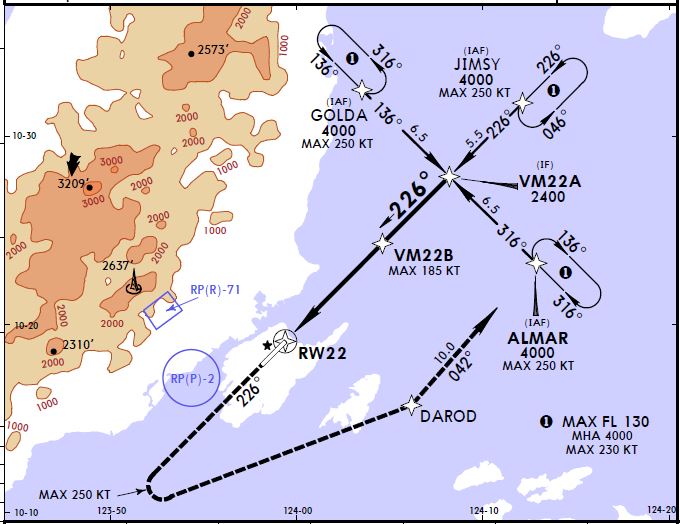Holding is a predetermined racetrack pattern maneuver that is performed within any airspace when instructed by ATC for further clearance, especially to land.
Holing patterns are basically a delaying tactic for Aircraft in any airspace where certain aircraft are sequenced for landing by the ATC. The reason behind holding could be a few!
- Approach delay if the airport is not ready for taking inbound aircraft for certain reasons,
- To control the flow of traffic in busy airspace, especially to sequence aircraft inbound for landing,
- Following a missed approach procedure,
- To perform a certain Emergency procedure to delay landing, in order to have extra time for pilot decision making,
Holding areas must be free from obstacles and holding patter’s size depends on the airspace congestion with other traffic.
Altitude for Holding & Airspeed:
Holding should normally follow Maximum endurance speed because this is how holding aircraft can conserve fuel. However, there could be also certain Airspeed limitation at certain altitudes for aircraft holding, instructed by ATC whatsoever. The holding speed limitation could be also provided on the IFR charts. The speed is basically calculated for the expected turn radius to keep aircraft clear of obstacles. if the pilot can not comply with a speed limitation, they should notify ATC immediately.
A pilot should fly at or below maximum holding speed when crossing a HOLDING FIX (VOR, NDB, Radial/ DME Fix, GPS Waypoint) when instructed by ATC to perform a holding. Here is the holding airspeed limitation below for commercial aircraft:
6000 MSL or below: 200 knots
6001 MSL to 14,000 MSL: 230 knots (However, max speed can be also restricted to 210 knots by ATC)
14,001 MSL to up: 265 knots
34,000 MSL above: Mach .83
However, Category A & Category B aircraft are restricted to 170 knots holding speed. I will discuss the category of aircraft in my other blogs for IFR discussion.
If it becomes necessary to fly at higher airspeed for holding patterns due to turbulence, the pilot should notify ATC immediately and reduce speed below max holding speed when it’s possible to safely operate the aircraft. Up to 34,000 MSL, Maximum airspeed is 280 knots or Mach 0.8 whichever is lower in penetrating turbulent air.
Holding Clearance by ATC:
ATC will include the following items in your holding clearance.
- Clearance to holding fix
- Direction to hold from holding fix
- Specific Radial, course or inbound track
- DME distance if used as Fix
- Altitude or Fight level (FL) to maintain
- Expect further clearance time (EFC)
Here is an example how ATC can instruct you for Holding in a busy airspace, to clear you before landing:
Standard format: (Call sign), (Holding instructions), (left/standard), (Altitude), (Max holding speed), (EFC)
RPC 4432, Hold at EDCON, left turns, maintain 6000, 100 knots expect further clearance at 1035Z
RPC 4432, Hold NW of Mactan VOR on the 330 Radial, maintain 6000, expect further clearance at 2215Z
Holding can have two types of patters:
- Standard Holding pattern (Right turn racetrack pattern)
- Non-Standard holding pattern (Left turn racetrack pattern)
Holding parts:
- Inbound leg
- Fix end leg
- Outbound leg
- Outbound end leg

Timing for Holding pattern:
Time for Holding can be judged by the pilot themselves. Usually, each leg is flown 1 minute for holding at or below 14,000 MSL with no wind. Pilots can increase the time to 1 and ½ minutes for inbound and outbound legs to increase the total holding time. Timing starts at the point when the pilot crosses the holding fix with the wings level. To adjust for headwind or Tailwind, the pilot can increase or decrease holding time for different legs in order to be inside the protected holding area.
Standard holding pattern:
The diagram below is a standard holding pattern (all right turns).

This is important for a student pilot to know what are the possible holding fix before performing a standard holding pattern. A holding fix could be a VOR, NDB, Radial given by ATC with DME distance, GPS waypoint, etc. The pilot can also choose a certain holding fix generated by the Flight Management system (FMS). All turns for holding usually should be at standard rate turns (3 degrees per second) or lesser for the adjustment of holding timing chosen for fix end and outbound end leg.
The student pilot can memorize this procedure below for practice standard holding with VOR.
Standard Holding Pattern (Right turn racetrack pattern)
- Over the station turn right on Outbound heading (head the radial)
- Set the proper OBS (Holding radial always below, inbound heading on top of the OBS)
- Change of flag (Abeam holding fix), time for 1 minute.
- After 1 minute, turn Right to intercept the holding Radial.
Non-Standard Holding Pattern:
If you understand Standard Holding pattern, Non-standard is just very easy. This patter has all turns left as the diagram depicted below.

For Non-standard, ATC will instruct you “Hold Non-standard / Hold left turns “. If ATC does not instruct you anything, then follow Standard Holding.
You can memorize the procedure below to practice Non standard Holding pattern once you start your IFR training.
Non- Standard Holding Pattern (Left turn racetrack pattern)
- Over the station turn left on Outbound heading (head the radial)
- Set the proper OBS (Holding radial always below, inbound heading on top of the OBS)
- Change of flag (Abeam holding fix), time for 1 minute.
- After 1 minute, turn Left to intercept the holding Radial.
Let’s learn from Captain Joe for a better understanding of Holding Basics discussed above.
These are the basics of Holding patterns for beginner IFR pilot students. I will discuss Holding Entry in my other blog. Watch out for my next blog! Till then Fly safe.
